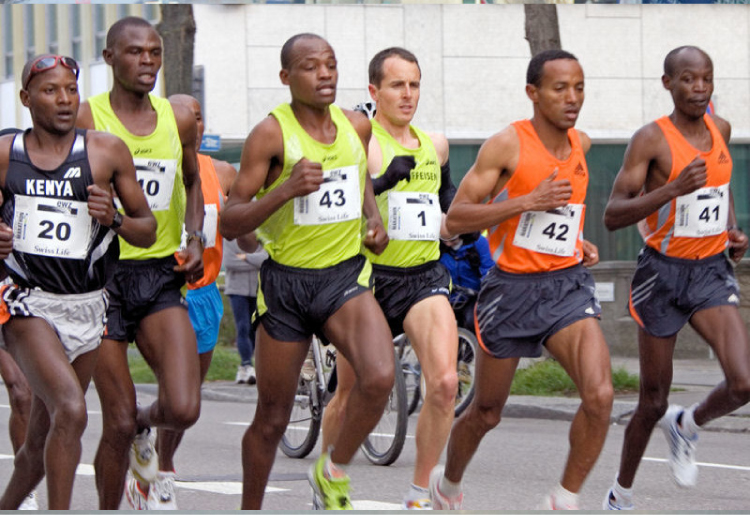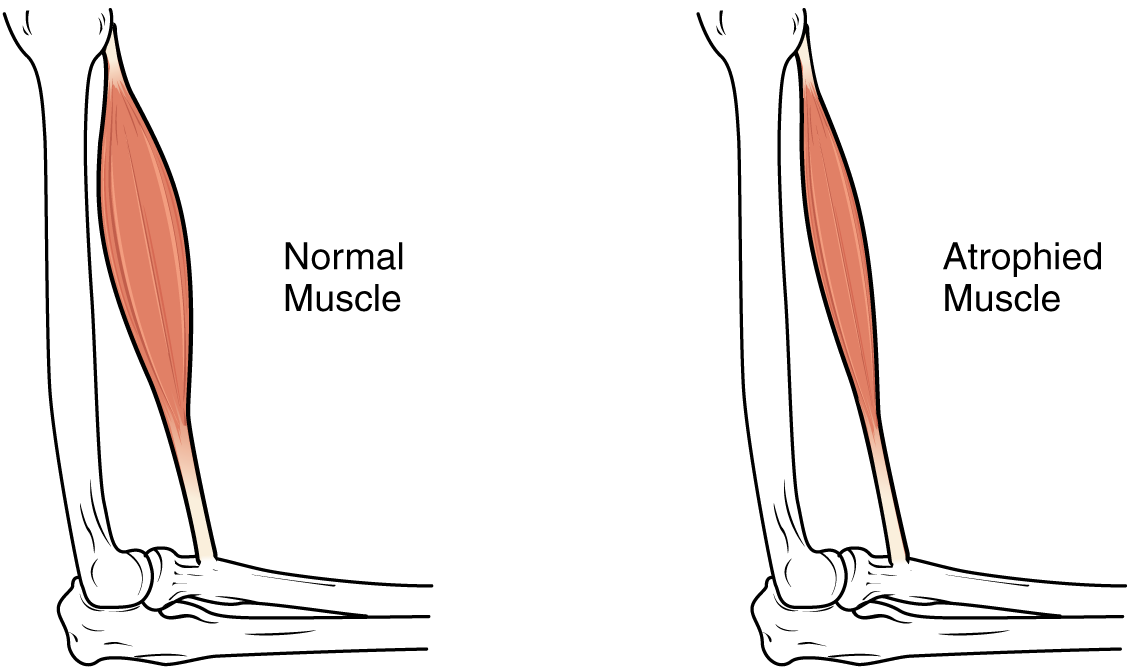Chapter 8. Muscle Tissue
8.6 Exercise and Muscle Performance
Learning Objectives
By the end of this section, you will be able to:
- Describe muscle hypertrophy and muscle atrophy
- Explain how endurance and resistance exercises can alter the internal physiology of skeletal muscles
- Explain how aging affects muscle tissue and performance
Physical training can alter the appearance of skeletal muscles and produce changes in muscle performance. Conversely, a lack of use can result in decreased muscle mass and performance. Although muscle cells can change in size, new cells are rarely formed when muscles grow. Instead, structural proteins are added to a muscle fiber in a process called muscle hypertrophy, resulting in an increase in fiber diameter. The reverse, when structural proteins are lost and muscle mass decreases, is called muscle atrophy.
Endurance Exercise
Slow fibers are predominantly used in endurance exercises that require limited force generation but involve numerous repetitions. The aerobic metabolism used by slow oxidative fibers allows them to maintain contractions over long periods. Endurance training modifies these slow fibers to make them even more efficient by producing more mitochondria to enable more aerobic metabolism and more ATP production. Endurance exercise can also increase the amount of myoglobin in a cell, as increased aerobic respiration increases the need for oxygen, and myoglobin serves as an oxygen storage supply for the mitochondria.
Endurance training can also trigger the formation of more extensive capillary networks around the fiber, a process called angiogenesis, to improve oxygen delivery and remove metabolic waste. To allow these capillary networks to supply the deep portions of the muscle, muscle mass does not greatly increase in order to maintain a smaller area for the diffusion of nutrients and gases. All of these cellular changes result in the ability to sustain low levels of muscle contractions for greater periods without fatiguing.
The proportion of SO fibers in muscle determines the suitability of a muscle for endurance, and may benefit those participating in endurance activities (Figure 8.6.1). Postural muscles have a large number of SO fibers, and relatively few FO and FG fibers, as they are continually contracting to keep the body erect. Endurance athletes benefit greatly from having muscles containing a larger proportion of SO fibers, but it is unclear if the most-successful marathoners are those with naturally high numbers of SO fibers, or whether the most successful marathon runners develop high numbers of SO fibers with repetitive training. Although some studies suggest that genetics play a critical role in determining the overall fiber proportions of SO to FG fibers in muscles with repetitive training having its greatest influence on fast oxidative fibers.

Resistance Exercise
Resistance exercises, as opposed to endurance exercise, require large amounts of FG fibers to produce short, powerful movements that are not repeated over long periods. The high rates of ATP hydrolysis and cross-bridge formation in FG fibers result in powerful muscle contractions. Thus, muscles used for power have a higher ratio of FG fibers compared to SO or FO fibers, and trained athletes possess even higher levels of FG fibers in their muscles. Resistance exercise affects muscles by increasing the formation of myofibrils, thereby increasing the diameter of muscle fibers. This added structure causes hypertrophy, or the enlargement of muscles, exemplified by the large skeletal muscles seen in body builders and other athletes (Figure 8.6.2). Because this muscular enlargement is achieved by the addition of structural proteins, athletes trying to build muscle mass often ingest large amounts of protein.

In addition to the increase in muscle fiber diameter, resistance training also increases the development of connective tissue, adding to the overall mass of the muscle. Increases in connective tissue help to contain muscles as they produce increasingly powerful contractions. Tendons also become stronger to prevent tendon damage, as the force produced by muscles is transferred to tendons that attach the muscle to bone. In contrast to endurance training, resistance training does not typically result in increased mitochondria, myoglobin, or capillary density. This is due to the fact that FG fibers rely on anaerobic metabolism and thus, do not require the same changes as observed in SO fibers.
For effective strength training, the intensity of the exercise must continually be increased. For instance, continued weightlifting without increasing the weight of the load does not increase muscle size. To produce ever-greater results, the weights lifted must become increasingly heavier, making it more difficult for muscles to move the load. The muscle then adapts to this heavier load, and an even heavier load must be used if even greater muscle mass is desired.
If done improperly, resistance training can lead to overuse injuries of the muscle, tendon, or bone. These injuries can occur if the load is too heavy, or if the muscles are not given sufficient time between workouts to recover, or if joints are not aligned properly during the exercises. Cellular damage to muscle fibers that occurs after intense exercise includes damage to the sarcolemma and myofibrils. This muscle damage contributes to the feeling of soreness after strenuous exercise, but muscles gain mass as this damage is repaired, and additional structural proteins are added to replace the damaged ones. Overworking skeletal muscles can also lead to tendon damage and even skeletal damage if the load is too great for the muscles to bear.
Everyday Connection – Performance-Enhancing Substances
Some athletes attempt to boost their performance by using various agents that may enhance muscle performance. Anabolic steroids are one of the more widely known agents used to boost muscle mass and increase power output. Anabolic steroids are a form of testosterone, a male sex hormone that stimulates muscle formation, leading to increased muscle mass.
Endurance athletes may also try to boost the availability of oxygen to muscles to increase aerobic metabolism by using substances such as erythropoietin (EPO), a hormone which triggers the production of red blood cells. The extra oxygen carried by these blood cells can then be used by muscles in aerobic respiration.
Human growth hormone (hGH) is another substance often taken to give athletes an advantage. Although it can facilitate building muscle mass, its main role is to promote the healing of muscle and other tissues after strenuous exercise. Increased hGH may allow for faster recovery after muscle damage, reducing the rest required after exercise, and allowing for more sustained high-level performance.
Although performance-enhancing substances often do improve performance, most are banned by governing bodies in sports and are illegal for non-medical purposes. Their use to enhance performance raises ethical issues of cheating because they give users an unfair advantage over nonusers. A greater concern, however, is that their long-term use can lead to serious health issues that are often significant, nonreversible, and in some cases fatal. The physiological strain caused by these substances is often greater than what the body can handle, leading to effects that are unpredictable and dangerous. For example, anabolic steroid use has been linked to infertility, aggressive behavior, cardiovascular disease, and brain cancer.
Everyday Connection – Aging and Muscle Tissue
Although muscle atrophy due to disuse can often be reversed with exercise, muscle atrophy with age, referred to as sarcopenia, is irreversible. This is a primary reason why even highly trained athletes succumb to declining performance with age. This decline is noticeable in athletes whose sports require strength and powerful movements, such as sprinting, whereas the effects of age are less noticeable in endurance athletes such as marathon runners or long-distance cyclists. As muscles age, muscle fibers die, and they are replaced by connective tissue and adipose tissue resulting in decreased muscle mass (Figure 8.6.3).
Because connective and adipose tissues cannot contract and generate force as muscle can, muscles lose the ability to produce powerful contractions. The decline in muscle mass causes a loss of strength, including the strength required for posture and mobility. This may be caused by a reduction in FG fibers that hydrolyze ATP quickly to produce short, powerful contractions. Muscles in older people sometimes possess greater numbers of SO fibers, which are responsible for longer contractions and do not produce powerful movements. There may also be a reduction in the size of motor units, resulting in fewer fibers being stimulated and less muscle tension being produced.

The effects of age-related atrophy are especially pronounced in people who are sedentary, as the loss of muscle cells is displayed as functional impairments such as trouble with locomotion, balance, and posture. This can lead to a decrease in quality of life and medical problems, such as joint problems because the muscles that stabilize bones and joints are weakened. Problems with locomotion and balance can also cause various injuries due to falls.
Sarcopenia can be delayed to some extent by exercise, as training adds structural proteins and causes cellular changes that can offset the effects of atrophy. These cellular changes may include greater numbers of mitochondria, increases in capillary density, and increases in the mass and strength of connective tissues.
Section Review
Muscle hypertrophy is an increase in muscle mass due to the addition of structural proteins. The opposite of muscle hypertrophy is muscle atrophy, the loss of muscle mass due to the breakdown of structural proteins. Endurance exercise causes an increase in cellular mitochondria, myoglobin, and capillary networks in SO fibers. Endurance athletes benefit from a high proportion of oxidative fiber types relative to FG fibers. Resistance exercise leads to muscle hypertrophy, primarily targeting FG fibers. Power-producing muscles have a higher density of FG fibers than SO fibers. Some athletes use performance-enhancing substances to enhance muscle performance. Muscle atrophy due to age is called sarcopenia and occurs as muscle fibers die and are replaced by connective and adipose tissue.
Review Questions
Critical Thinking Questions
Glossary
- angiogenesis
- formation of blood capillary networks
- atrophy
- loss of structural proteins from muscle fibers
- hypertrophy
- addition of structural proteins to muscle fibers
- sarcopenia
- age-related muscle atrophy
Glossary Flashcards
This work, Human Physiology, is adapted from Anatomy & Physiology by OpenStax, licensed under CC BY. This edition, with revised content and artwork, is licensed under CC BY-SA except where otherwise noted.
Images from Anatomy & Physiology by OpenStax are licensed under CC BY except where otherwise noted.
Access the original for free at OpenStax.
Image Descriptions
Figure 8.6.3. This side-by-side anatomical diagram compares a normal muscle with an atrophied muscle in the lower leg. Both illustrations show a lateral view of the leg from knee to foot, with the calf muscle (gastrocnemius) highlighted in coral pink. The left image, labeled “Normal Muscle,” displays a well-developed calf muscle with substantial volume and typical fusiform shape, extending from behind the knee down toward the Achilles tendon. The muscle belly appears full and rounded with visible internal striations indicating healthy muscle fibers. The right image, labeled “Atrophied Muscle,” shows the same anatomical region but with a noticeably reduced muscle mass. The atrophied muscle appears significantly thinner and more elongated, with diminished cross-sectional area throughout its length. The muscle’s characteristic bulge is flattened, and the overall volume is substantially decreased compared to the normal muscle. Both diagrams show the underlying bone structure of the tibia and fibula, as well as the foot bones, providing anatomical context for the muscle comparison. [Return to Figure 8.6.3]
Report an Error
Did you find an error, typo, broken link, or other problem in the text? Please follow this link to the error reporting form to submit an error report to the authors.
